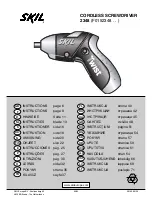
The following example illustrates the process given an
installation using the machine at an 18% pitch on level
ground:
•
Insert the first 3 m (10 ft) of drill bit/pipe into the ground
with no steering. The end of the drill bit will be 53 cm
(21 inches) deep (
Figure 56
1.
18% pitch
3.
96 cm (38 inches)
5.
119 cm (47 inches)
2.
53 cm (21 inches)
4.
114 cm (45 inches)
6.
10.6 m (35 ft)
•
Begin steering up for the next 3 m (10 ft), pushing the
pipes in at the maximum pitch change of 8%. This results
in a change of pitch from 18% at the beginning of the 3 m
(10 ft) to 10% at the end of the 3 m (10 ft) for an average
pitch of 14%. Given that, the drill head lowers another 43
cm (17 inches) and is now 96 cm (38 inches) deep.
•
Continuing steering up for the next 3 m (10 ft) at an 8%
pitch change, your pitch will change from 10% to 2% for
an average pitch of 6%. Given that, the drill head lowers
another 18 cm (7 inches) and is now 114 cm (45 inches)
deep.
•
Leveling the drill head from 2% to 0% takes less than 1.5
m (5 ft) more for a final depth of 119 cm (47 inches).
Reaching this final point took 3-1/2 pipes 3 m (10 ft)
long. So for this example your entry point should be 10.6
m (35 ft) back from the beginning-at-depth point of your
installation.
Important:
You can use the information contained in
this section to determine both the space needed to steer
up to the exit point if needed and also to steer around
obstacles.
Mapping the Bore
With the information you gathered previously, map out the
route of the bore, identifying the following so that you can
mark the site later:
•
Entry point
•
Location of the machine and supporting equipment
•
Beginning of bore at depth
•
Any obstacles that you need to steer around and the
locations where you need to start steering to get around
or under them
•
Any utility lines that you will need to cross
•
Slope and soil changes along the path that will affect the
bore
•
End of the bore at depth
•
Exit location if different than the end of the bore
55
















































